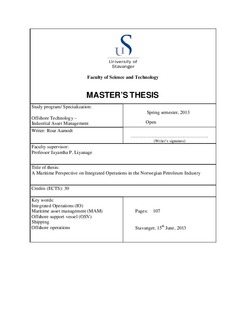| dc.contributor.author | Aamodt, Roar | |
| dc.date.accessioned | 2013-09-20T09:05:51Z | |
| dc.date.available | 2013-09-20T09:05:51Z | |
| dc.date.issued | 2013 | |
| dc.identifier.uri | http://hdl.handle.net/11250/183083 | |
| dc.description | Master's thesis in Offshore technology | no_NO |
| dc.description.abstract | Over the last few years the production process in the offshore Oil & Gas (O&G) industry has concentrated on innovative subsea solutions. This development has increased the need for advanced multi-purpose Offshore Support Vessels (OSV). Their role in oil field development has widened the intersection between the traditional petroleum and maritime sector, leaving the borderline between them somewhat diffused. This has increased the need for interfacing the two business sectors. As a response to the demand of innovative and efficient solutions, the O&G industry has implemented its novel operation scenario solution, termed Integrated Operations (IO). However, this study shows that the maritime sector is still oblivious to IO and its proven effect in the Norwegian Continental Shelf (NCF). The remarkable difference in the operational approach between the two sectors is a challenging situation as there is a need for a seamless interface between the two operational environments.
This study describes the opportunities and limitations of adapting the IO approach into Maritime Asset Management (MAM) and specifically in the OSV management companies. The study has a practical approach to actual maritime operations, using specific problems encountered during normal operations, critical maintenance operations and an environmental initiative project. By the use of three industrial case studies, supported by interviews, the frictional elements in the operational interface of the two sectors have been identified. This has enabled the outlining of a new organizational approach to MAM. However, in order to utilize the full potential of IO several identified obstacles needs to be acknowledged by the maritime industry and mitigated through a joint effort and an open and including process. The study outlines 13 recommended actions specified to the authority, the oil field operator and the OSV companies for facilitating full implementation of IO into the maritime sector. | no_NO |
| dc.language.iso | eng | no_NO |
| dc.publisher | University of Stavanger, Norway | no_NO |
| dc.relation.ispartofseries | Masteroppgave/UIS-TN-IKM/2013; | |
| dc.subject | offshore technology | no_NO |
| dc.subject | industrial asset management | no_NO |
| dc.subject | maritime asset management (MAM) | no_NO |
| dc.subject | offshore teknologi | no_NO |
| dc.subject | offshore operations | no_NO |
| dc.subject | shipping | no_NO |
| dc.subject | integrated operations (IO) | no_NO |
| dc.subject | offshore support vessel (OSV) | no_NO |
| dc.subject | industriell teknologi | no_NO |
| dc.title | A maritime perspective on integrated operations in the Norwegian petroleum industry | no_NO |
| dc.type | Master thesis | no_NO |
| dc.subject.nsi | VDP::Technology: 500::Marine technology: 580::Offshore technology: 581 | no_NO |
